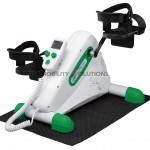Benefits of a Passive Exercise
Physical exercise benefits all of us without exception; but, for the disabled; elderly; stroke victims; convalescing patients and those just out of rehab, traditional exercise routines can be too painful and sometimes downright impossible. Thus, decreased mobility in these sectors pose a major barrier to maintaining health and fitness.
A passive exercise machine overcomes this barrier and is an extremely cost effective way to increased fitness within the home environment. They are highly regarded by most healthcare professionals and many medical aids will cover the cost.
The highest quality machines always have built in safety features such as an automatic cut off switch; adjustable speeds with reverse speed; plus calorie counter, distance counter etc. They are neat and portable and a huge plus is they can be used whilst the patient is sitting up or lying down so even someone on total bed rest can benefit from regular exercise.
They can also be used to exercise lower or upper body depending on patients’ needs and many can switch between passive or active.
The benefits of a passive exercise are numerous; including:
- Improves circulation by preventing blood from pooling in the lower torso which could lead to ulcers or bedsores;
- Relieves swollen ankles and legs due to increased blood circulation;
- Increase in cardiac capacity, allowing oxygen-rich blood to be pumped throughout the body;
- Promotion of flexibility within the ankles, knees, hips and spine;
- Decrease in muscle spasms – increased circulation and relaxed, more flexible muscles;
- Prevents stiffening of joints ;
- Reduces joint pain caused by stiffness;
- May help improve contractures caused by atrophy and shortening of muscles or joints;
- Enables anyone to exercise in the comfort of their home whilst watching television or reading;
- Cost effective way of maintaining ongoing rehabilitation without costly medical bills.


